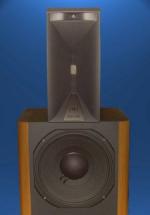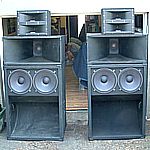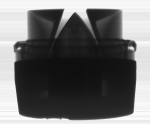Drug out a pair of 813C monitors and set them up. Owned them for a while, but never used them do to space limitations. Had OLDMICS put new surrounds on the 2215s, and we tried them out. Heard a little breaking up from one of the tweeters, and figured either the diaphragm or crossover was going. OLDMICS and WIDGET both felt the diaphragm was the likely culprit, so I removed both 801Cs and took them to John (OLDMICS) to evaluate, and replace the diaphragms.
While he was looking them over, he noticed the spring actuated wire attachments on the midrange/woofer (one colored Red, and one Black) were inverse from the + and - signs on the UREI decal located just below them on one spoke of the frame. So he takes out a phase tester and finds that to make the woofer section pull in on a positive charge, as the tweeter and 2215 helper woofer do, we have to follow the color coded spring clips, and ignore the UREI decal. There was some discussion as to whether the crossover might invert phase, but after checking the schematic, he felt it wouldn't.
As I reinstalled the drivers, each cabinet was tested with the phase test from the rear binding posts. All three driver pulling in with the positive charge. In the system I'm using, the preamp inverts phase and the amp doesn't, so we attach the speaker/amp wires red/red and black/black thereby inverting polarity at the speaker cabinet. When we run the phase test through the system, all the drivers are now pushing when given the positive charge.
Everything is now in absolute phase. So........should it be? Is the midrange woofer supposed to be out of phase with the tweeter/helper woofer? Is the UREI decal wrong? Has this been covered in 1000 threads already? Are a lot of people listening to out of phase speakers because they followed the decal? Are my drivers unique? We listened to music, and audible phase tests, with the woofer wired both ways, and there is a difference.
Appreciate any knowledge you can share. Diaphragms cured the breaking up for anyone still interested in that detail.



 Reply With Quote
Reply With Quote




 by definition phase is relative, it's important when it's taken against something else.
by definition phase is relative, it's important when it's taken against something else.


 ) .
) .